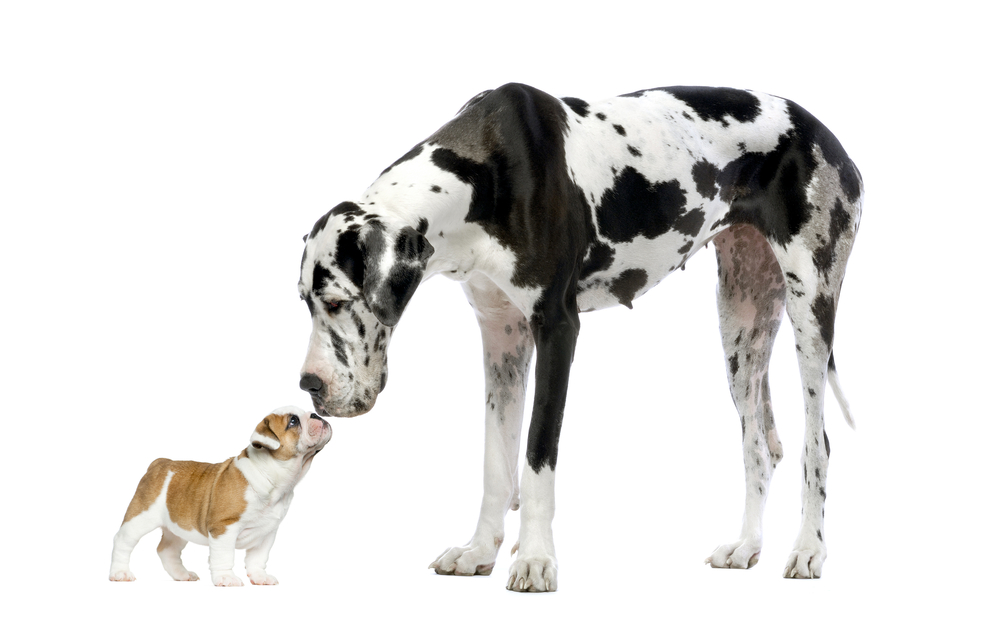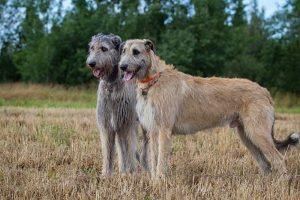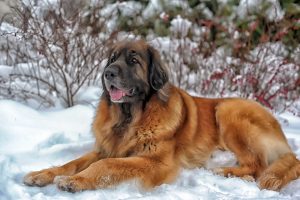It’s well-known that Great Danes are great in stature and that Bernese Mountain Dogs live up to their name by being practically mountain-sized. But aside from these famously colossal puppers, what are the biggest dogs in the world?
If you’re curious about the tallest, heaviest, and most grandly proportioned dog breeds, let’s put that curiosity to rest.
What are the biggest dogs in the world?
1. English Mastiff
English Mastiffs are big, sure, but did you know they’re actually the biggest? The American Kennel Club (AKC) considers them the largest breed of all, which might come as a bit of a shock considering they’re not exactly the most well-known of big dog breeds.
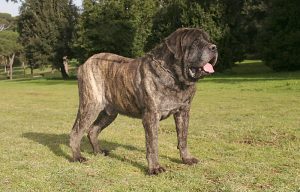
English Mastiffs don’t win out in the height department, but the weight department. While males typically weigh between 75 and 100 kilograms (165 and 220 pounds), these bulky canines have been known to weigh up to 155 kilograms (341 pounds).
In fact, the heaviest dog on record – an English Mastiff named Zorba, who was weighed in 1989 – clocked in at exactly that. Zorba was, supposedly, the size of a small donkey!
2. Irish Wolfhound
Now for a doggo that delivers in height. The AKC considers the Irish Wolfhound to be the tallest dog breed – even taller than the Great Dane. Measuring an average of 86-89 centimetres (34-35 inches) at the shoulder for males, and 81-86 centimetres (32-34 inches) for females, this is one towering pooch.
Despite their gangly appearance, Irish Wolfhounds can also weigh a lot: up to 81 kilograms for males and 63 kilograms for females.
3. Great Dane
A list of the biggest dog breeds isn’t complete without the most famous large doggo of all: the Great Dane. Surprisingly, Great Danes aren’t that heavy. Males generally weigh 63-80 kilograms (140-175 pounds), while females average 49-63 kilograms (110-140 pounds).
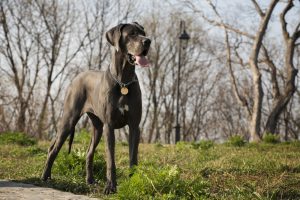
That said, they certainly are tall. Males often measure 76-81 centimetres (30-32 inches) from the shoulder and females 71-76 centimetres (28-30 inches).
Interestingly, it’s a Great Dane, not an Irish Wolfhound, who holds the record for the tallest dog. A Great Dane named Zeus was an incredible 111 centimetres (44 inches) tall. To give you an idea of just how tall he was, Zeus could comfortably drink from the kitchen tap while remaining on all-fours.
4. Newfoundland
The Newfoundland is a shaggy, sharp, and sheerly wonderful dog. The breed also happens to be rather large.
These gentle giants were originally bred as working dogs. In the past, they were required to use their strong muscles and hefty size to pull carts, haul fishing nets, and perform other big-dog duties.
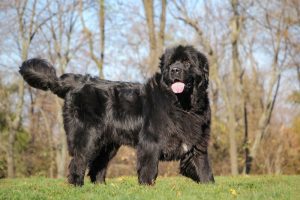
So, just how big are they? Male Newfoundlands measure around 71 centimetres (28 inches) tall, while females are around 66 (26 inches) centimetres tall. In terms of weight, males clock in at up to 68 kilograms (150 pounds) and females up to 54 kilograms (120 pounds).
5. Leonberger
The dog breeds above are renowned for being big. So, we thought we’d throw a slightly more obscure doggo into the mix. The Leonberger is a German mountain dog that combines three of the biggest dog breeds: the Newfoundland, Saint Bernard, and Great Pyrenees.
Naturally, the Leonberger has inherited the grand size of its ancestors. Males stand up to 80 centimetres (31.5 inches) tall and weigh up to 77 kilograms (170 pounds). Females can be up to 75 centimetres (29.5 inches) tall and weigh up to 63 kilograms (140 pounds).
Other honourable mentions
We were hoping to cover a few more breeds, but unsurprisingly, the giant dogs we’ve mentioned took up way too much space. So, here are a few more honourable (and sizeable) mentions:
- Scottish Deerhound
- Dogue de Bordeaux
- Neapolitan Mastiff
- Bernese Mountain Dog
- Saint Bernard
- Great Pyrenees
What do I need to know about owning one of the biggest dogs in the world?
If you opt for a big breed, prepare for a few perks and a few struggles.
The perks of owning a giant dog
There are many benefits to owning a giant dog, not least the fact that they make excellent pillows.
They often have great temperaments
Despite their imposing size, big dogs are often gentle giants. Many are happy to laze around for most of the day, and they make some of the best dog breeds for children.
There are several large dog breeds that are also incredibly easy to train, such as the Bernese Mountain Dog, Golden Retriever, and Labrador. Plus, Owners of giant dogs report that their pooches are often more confident and self-assured.
They generally need more exercise
Depending on your exercise preferences, this may not necessarily be a perk. But we reckon anything that gets us up and moving has to be a good thing! Plus, big dogs are great for taking on hikes, as their long legs can keep up.
A quick note about exercising a big dog: when they’re a puppy, don’t over exercise them. Their joints take longer to develop than smaller breeds, and overdoing it can put a strain on their growing bodies. This may result in joint problems further down the track.
They make good guard dogs
Many big dog breeds have actually been bred as guard dogs – the Great Dane and Neapolitan Mastiff among them. But even if they haven’t, their sheer size can be a great deterrent for intruders. While you’re out walking, particularly at night, you may also feel safer with a big dog strolling alongside you.
The struggles of owning a giant dog
Owning a big dog can be great, but they’re not without their challenges.
They tend to cost more
Big dogs simply need more stuff. More food, more toys, and more medication if they get sick. (Their sheer size often means they need bigger doses of the latter.) And what does all this require? Spending more money.
Here are a couple of tips when it comes to food and toys.
You’ll probably find that your big dog eats quite a lot. Even so, feeding them premium raw dog meals or top-grade kibble that adequately meet their nutritional needs will ensure their food is equal parts quantity and quality.
As well, giving them the best dog toys appropriate for their size will mean they churn through them less rapidly. There’s no use handing them a tiny chew toy for dogs if they’ll just tear right through it!
They need more space
Hoping to introduce a German Shepherd to your one-bedroom inner-city apartment? You may want to reassess. Many big dog breeds require large living quarters, along with ample outdoor space. This is to ensure they have enough room to expend their energy.
This isn’t necessarily true of all big dog breeds: Great Danes, Great Pyrenees, and Mastiffs are mostly content spending the majority of their days napping and may be fine in a small unit. Generally speaking, though, smaller puppers make some of the best dog breeds for apartment living.
They take longer to mature
Again, we’re not sure which camp this one falls into. You may love the thought of enjoying the puppy stage for an extended period of time. In this case, a longer path towards full maturity is a blessing.
However, if you’re keen to move past it, know that bigger dogs can take up to twice as long to mature as smaller dogs. And sadly, as many of us know, big dog breeds tend to live shorter lives, too.

